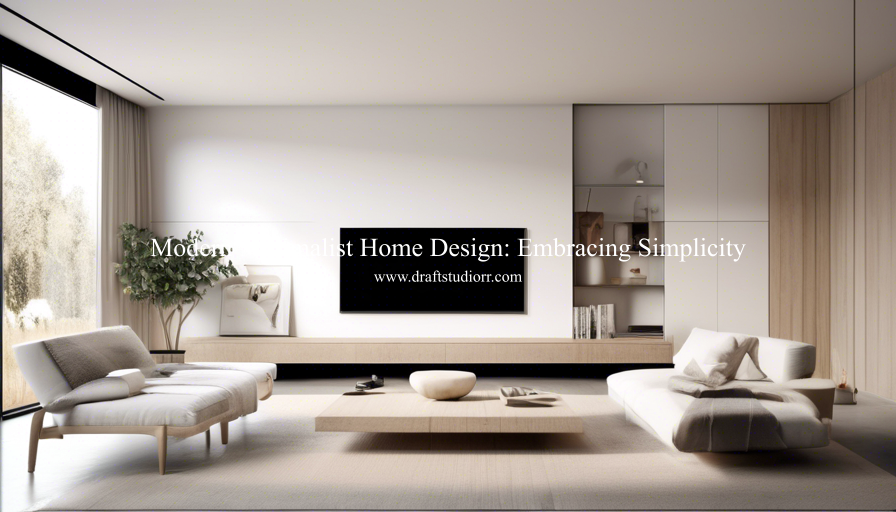Modern Minimalist Home Design: Embracing Simplicity
A Guide to Creating a Tranquil and Functional Living Space
The allure of minimalism lies in its ability to simplify, to curate a living space that is both visually appealing and incredibly functional. Modern minimalist home design takes this principle to heart, embracing clean lines, muted palettes, and a focus on quality over quantity. This aesthetic transcends trends, offering timeless elegance and a sense of serenity that resonates deeply.
What is Modern Minimalist Home Design?
Modern minimalist home design is about stripping away the unnecessary. It's a philosophy of living that prioritizes functionality, clarity, and a sense of openness. This style embraces:
- Simple Forms: Clean lines, geometric shapes, and absence of unnecessary ornamentation define the aesthetic.
- Neutral Palette: Predominantly white, black, gray, and beige with accents of natural wood or muted earth tones create a soothing ambiance.
- Natural Materials: Wood, stone, concrete, and leather add warmth and texture while maintaining a minimalist aesthetic.
- Open Floor Plans: Seamless transitions between living areas promote a sense of spaciousness and flow.
- Minimalist Furniture: Functionally designed, sleek pieces with clean lines and neutral upholstery are key.
- Hidden Storage: Keeping clutter out of sight is paramount, achieved through built-in storage solutions and carefully selected furniture with storage capabilities.
The Benefits of Embracing Simplicity
Beyond its aesthetic appeal, modern minimalist design offers a multitude of benefits:
- Reduced Stress: Clutter can create a feeling of chaos and overwhelm. A minimalist home offers a sense of peace and tranquility, promoting relaxation and focus.
- Enhanced Functionality: Every piece of furniture and decor serves a purpose, maximizing space and ensuring efficient living.
- Increased Light: Open floor plans and the use of natural materials allow for maximum light penetration, creating a bright and airy environment.
- Time Savings: A minimalist home is easier to maintain, requiring less cleaning and organization, freeing up valuable time.
- Sustainability: Choosing quality materials and furniture that lasts a lifetime promotes a sustainable lifestyle.
Key Elements of Modern Minimalist Home Design
To achieve a truly minimalist home, consider incorporating these key elements:
1. Color Palette:
The foundation of minimalist design is a neutral color palette. White, black, gray, and beige serve as the primary hues, creating a calm and serene atmosphere. Accent colors can be introduced sparingly, using natural wood tones, muted earth tones, or pops of bold color to add visual interest.
2. Furniture:
Minimalist furniture should be functional, simple, and elegant. Choose pieces with clean lines, neutral upholstery, and minimal ornamentation. Multifunctional furniture, such as a sofa bed or a coffee table with storage, is essential for maximizing space.
3. Lighting:
Lighting plays a vital role in creating the desired ambiance. Natural light should be maximized through large windows and minimal window coverings. Artificial lighting should be well-designed and strategically placed to illuminate specific areas without being overly bright or harsh.
4. Artwork:
Minimalist art is typically characterized by its simplicity, abstract forms, and muted color palette. A few well-chosen pieces can add visual interest and personality to the space without overwhelming the design.
5. Accessories:
Minimalist accessories should be carefully curated and kept to a minimum. Opt for pieces with simple designs and neutral colors that complement the overall aesthetic.
Inspiration: Modern Minimalist Home Design Examples
For those seeking inspiration, these examples showcase the beauty and functionality of modern minimalist design:
- The Japanese Zen Garden: A perfect example of how minimalism can create a serene and meditative space.
- The Scandinavian Minimalist Home: Known for its clean lines, natural materials, and emphasis on functionality.
- The Modern Loft: Often features open floor plans, exposed brick, and industrial accents for a contemporary take on minimalism.
Tips for Achieving Modern Minimalist Home Design
- Declutter: Start by getting rid of anything you don't need or use. Donate, sell, or discard unwanted items.
- Focus on Functionality: Choose furniture and accessories that serve a purpose and enhance your daily life.
- Embrace Natural Light: Maximize natural light by removing unnecessary window coverings.
- Use Mirrors: Mirrors create the illusion of more space and reflect natural light.
- Simplify Your Storage: Invest in hidden storage solutions like built-in cabinets or drawers.
- Choose High-Quality Materials: Invest in durable, well-made furniture and décor that will last.
- Be Mindful of Your Purchases: Consider the function and aesthetic of each item before bringing it into your home.
Conclusion: Embracing a Minimalist Lifestyle
Modern minimalist home design is not just an aesthetic trend; it's a philosophy that promotes simplicity, functionality, and tranquility. By embracing these principles, you can create a space that is both visually appealing and conducive to a more mindful and fulfilling life. Embrace the beauty of simplicity and discover the transformative power of minimalist home design.


